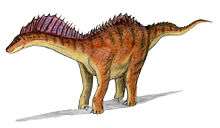La Amarga Formation
| La Amarga Formation Stratigraphic range: Barremian - early Aptian | |
|---|---|
| Type | Geological formation |
| Sub-units |
Puesto Antigual Member Bañados de Caichigüe Member Piedra Parada Member |
| Underlies | Lohan Cura Formation |
| Overlies | Agrio Formation |
| Thickness | 160 m |
| Location | |
| Region | Río Negro, Mendoza & Neuquén Provinces |
| Country |
|
| Type section | |
| Named for | La Amarga Arroyo & China Muerta Hill |
| Named by | Musacchio, 1970 |
The La Amarga Formation is a geologic formation with outcrops in the Argentine provinces of Río Negro, Neuquén, and Mendoza. It is the oldest Cretaceous terrestrial formation in the Neuquén Basin.
The type locality is La Amarga Arroyo and China Muerta Hill (Musacchio, 1970). The La Amarga Formation unconformably overlies the marine Agrio Formation of the Mendoza Group. It is in turn overlain by the Lohan Cura Formation, separated by another unconformity.
Age
Era: Mesozoic
Period: Early Cretaceous
Faunal stage: Barremian through early Aptian
Absolute Age: 130 to ~120 mya
Composition
There are three members within the La Amarga Formation.
The oldest is the Puesto Antigual Member, which is approximately 28.9 meters thick and consists mainly of sandstone deposited in the channels of a braided river system. Paleosols, or soil deposits, are well-developed.
The Bañados de Caichigüe Member is the next highest, approximately 20.9 meters thick. Alternating limestones, shales, and siltstones make up this member, indicating a lacustrine (lake) environment.
Youngest and thickest is the Piedra Parada Member, approximately 109.4 meters thick in some sections. This member consists of alternating sandstones and siltstones from an ancient alluvial plain, with some swamp and paleosol deposits.
Vertebrate paleofauna
Most of the tetrapod fossils found in the La Amarga come from the Puesto Antigual Member, including:
- a crocodilian (Amargasuchus)
- a dicraeosaurid sauropod (Amargasaurus)[1]
- a diplodocoid sauropod (Zapalasaurus)
- a titanosaurian sauropod
- an abelisauroid theropod (Ligabueino)
- a stegosaur (Amargastegos)
- a mammal (Vincelestes)
Possible indeterminate stegosaurid remains located in Provincia de Neuquen, Argentina.[1]
| Dinosaurs of the La Amarga Formation | ||||
|---|---|---|---|---|
| Genus | Species | Presence | Notes | Images |
|
A. cazaui[1] |
Geographically located in Provincia de Neuquen, Argentina.[1] |
"Braincase and associated postcranial skeleton."[2] |
| |
|
L. andesi[1] |
Geographically located in Provincia de Neuquen, Argentina.[1] |
|||
|
A. brevicollus |
"Some dorsal osteoderms, the cervical and caudal vertebrae, and one skull bone." |
|||
|
A. macni |
"six tail vertebrae, a shoulder blade, a thighbone, and an astragalus." |
|||
See also
Footnotes
- 1 2 3 4 5 6 7 8 Weishampel, David B; et al. (2004). "Dinosaur distribution (Early Cretaceous, South America)." In: Weishampel, David B.; Dodson, Peter; and Osmólska, Halszka (eds.): The Dinosauria, 2nd, Berkeley: University of California Press. Pp. 563-570. ISBN 0-520-24209-2.
- ↑ "Table 13.1," in Weishampel, et al. (2004). Page 264.
- ↑ "Table 3.1," in Weishampel, et al. (2004). Page 50.
References
- Leanza, H.A, Apesteguia, S., Novas, F.E. & de la Fuente, M.S. 2004. Cretaceous terrestrial beds from the Neuquén Basin (Argentina) and their tetrapod assemblages. Cretaceous Research. 25(1): 61-87.
- Musacchio, E. 1970. Ostrácodos de la superfamilias Cytheraceae y Darwinulaceae de la Formación La Amarga (Cretácico inferior), provincia del Neuquén, Argentina. Ameghiniana. 7: 301-318.
